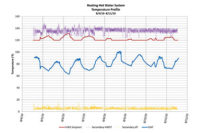Continuing with the theme from last month, this column presents another real-life example of how trend analysis, if done thoughtfully, can uncover wasted energy that no one even suspected. Trend analysis is not only good for confirming that systems are meeting the owner’s temperature, relative humidity, air quality, pressurization, and other needs over time, it is also good for finding hidden energy savings opportunities.
This month’s system was a large constant volume reheat air-handling system serving museum gallery spaces in the U.S.’s upper Midwest. Clearly, converting to variable air volume operation would be an energy conservation opportunity for this system, but that’s evident without much thought or analysis.
Figure 1 is a trend graph of three key AHU temperatures — return air temperature, outside air temperature, and mixed air temperature — over nine days in the fall. This appears to demonstrate a reasonably well-performing system. The return air temperature (essentially the average space temperature) holds steady between 70-72°F as the outside air temperature varies from 45° and 80°. The mixed air temperature equals the return air temperature during overnight hours when the AHU is off and the outside air dampers are closed.
However, if you add in the discharge air temperature and discharge air temperature set point to the trend graph (Figure 2), the AHU performance starts looking suspect. When the AHU is on, the average discharge air temperature is maintained at the set point, but the discharge air fluctuates wildly between about 53° and 80°.
In order to study this more closely, we narrowed the trend period to 24 hours and added the heating and cooling control valve output points. Bingo! Figure 3 shows very clearly how the heating and cooling valves were fighting each other, trying to maintain the set point discharge air temperature. The heating coil opened too far before backing off, resulting in the discharge air temperature rising well above the set point and causing the chilled water valve to start opening to lower the temperature.
What was particularly annoying about this situation during the fall transition season was that the mixed air temperature was consistently about 5° lower than the discharge air temperature set point. Mechanical cooling should not have been needed at all, and little to no heating should have been required. Instead of coasting along in “free cooling” mode, the system was alternately consuming heating hot water and chilled water all day every day.
This control loop should never have been left tuned like this. In addition, it’s usually advisable to program logic to prevent the heating valve from opening until the cooling valve is fully closed and vice versa. When the controls contractor was summoned back to the building two years after it was constructed, he spent about 15 minutes solving the problem. As a result, the museum immediately started saving $12,500 per year in energy costs.






